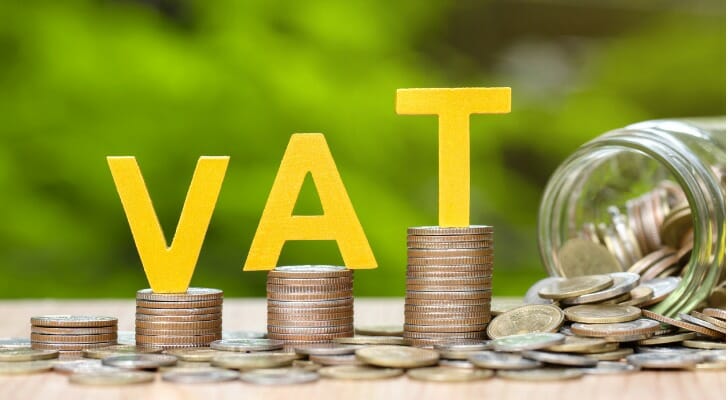
VAT is designed to be a transparent tax, where businesses collect the tax on behalf of the government and pass it along to the end consumer. This makes VAT different from other sales taxes, which are typically charged only at the final point of sale.
Understanding VAT is crucial for businesses and individuals who engage in international trade or operate in countries with a VAT system. In this comprehensive guide, we’ll cover everything you need to know about VAT, including how it works, VAT rates and exemptions, the registration process, and VAT compliance.
How does VAT work?
VAT is a multi-stage tax that is charged at each step of the supply chain, from the manufacturer to the wholesaler, retailer, and finally, the end consumer. Here’s how the VAT system typically works:
- Manufacturer: The manufacturer sells a product to a wholesaler and charges VAT on the sale.
- Wholesaler: The wholesaler sells the product to a retailer and charges VAT on the sale. The wholesaler can claim a credit for the VAT paid to the manufacturer.
- Retailer: The retailer sells the product to the final consumer and charges VAT on the sale. The retailer can claim a credit for the VAT paid to the wholesaler.
- Consumer: The final consumer pays the full price, including the VAT charged by the retailer.
The key aspect of VAT is that businesses can claim a credit for the VAT they have paid on their inputs, effectively passing the tax burden on to the end consumer. This ensures that VAT is only paid on the value added at each stage of the supply chain, rather than on the full retail price.
VAT rates and exemptions
VAT rates can vary significantly between countries and even within the same country, depending on the type of goods or services being sold. Here are some common VAT rates and exemptions:
|
Country |
Standard VAT Rate |
Reduced VAT Rates |
Exempt Goods/Services |
|
United Kingdom |
20% |
5%, 0% |
Certain food items, children’s clothing, medical services |
|
Germany |
19% |
7% |
Certain food items, books, newspapers, public transport |
|
France |
20% |
5.5%, 10% |
Certain food items, books, newspapers, medical services |
|
India |
18% |
5%, 12% |
Certain food items, agricultural products, education, healthcare |
It’s important to note that VAT exemptions and reduced rates can be complex and subject to change, so it’s crucial to stay up-to-date with the latest VAT regulations in the countries where you operate.
VAT registration process
Businesses that are required to charge VAT must register for VAT in the countries where they have a taxable presence. The VAT registration process typically involves the following steps:
- Determine your VAT registration requirements: Understand the VAT registration thresholds and requirements in the countries where you operate.
- Gather the necessary documentation: Prepare the required documents, such as proof of business registration, tax identification numbers, and financial statements.
- Submit the VAT registration application: Complete the VAT registration form and submit it to the relevant tax authority.
- Obtain your VAT registration number: Once your application is approved, you will receive a VAT registration number that must be used on all your invoices and transactions.
- Comply with ongoing VAT obligations: Regularly file VAT returns, pay the VAT due, and maintain accurate records for potential audits.
The VAT registration process can vary significantly between countries, so it’s important to familiarize yourself with the specific requirements in each jurisdiction where you have a taxable presence.
VAT audits and compliance
Businesses that are registered for VAT are subject to regular audits and compliance checks by the tax authorities. VAT audits are designed to ensure that businesses are correctly calculating, collecting, and remitting the VAT they owe.
During a VAT audit, the tax authorities may request the following information:
- Invoices and sales records
- Purchase invoices and expense records
- VAT returns and payments
- Accounting records and financial statements
It’s crucial to maintain accurate and up-to-date VAT records, as non-compliance can result in penalties, interest charges, and even criminal prosecution in some cases.
To ensure VAT compliance, businesses should:
- Regularly review their VAT obligations and update their processes as needed
- Implement robust internal controls and record-keeping procedures
- Seek professional advice from a VAT specialist when necessary
- Respond promptly to any VAT-related inquiries or audits from the tax authorities
By staying on top of your VAT compliance, you can avoid costly penalties and maintain a good relationship with the tax authorities.
VAT in different countries
VAT is a global tax system, but the specific rules and regulations can vary significantly between countries. Here are a few examples of how VAT works in different parts of the world:
European Union (EU): The EU has a harmonized VAT system, with a standard VAT rate of at least 15% and reduced rates of at least 5% for certain goods and services. However, individual EU member states have the flexibility to set their own VAT rates and exemptions within these parameters.
United States: The United States does not have a federal-level VAT or GST. Instead, some states and local jurisdictions impose their own sales taxes, which can vary widely in terms of rates and exemptions.
Conclusion
Value-Added Tax (VAT) is a complex but crucial tax system that affects businesses and consumers around the world. Understanding how VAT works, the various rates and exemptions, the registration process, and compliance requirements is essential for anyone engaged in international trade or operating in countries with a VAT system.
By staying informed and proactively managing your VAT obligations, you can ensure that your business is compliant, minimize your tax liabilities, and maintain a positive relationship with the tax authorities.












